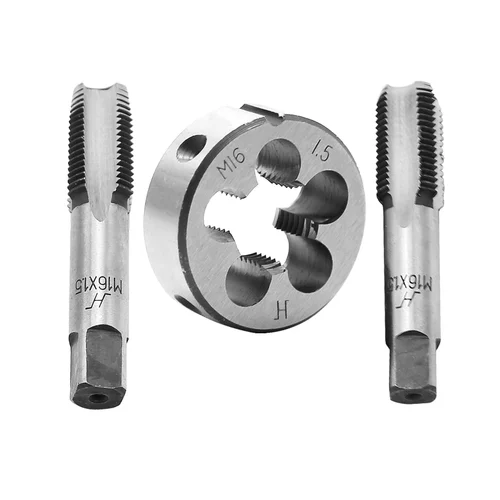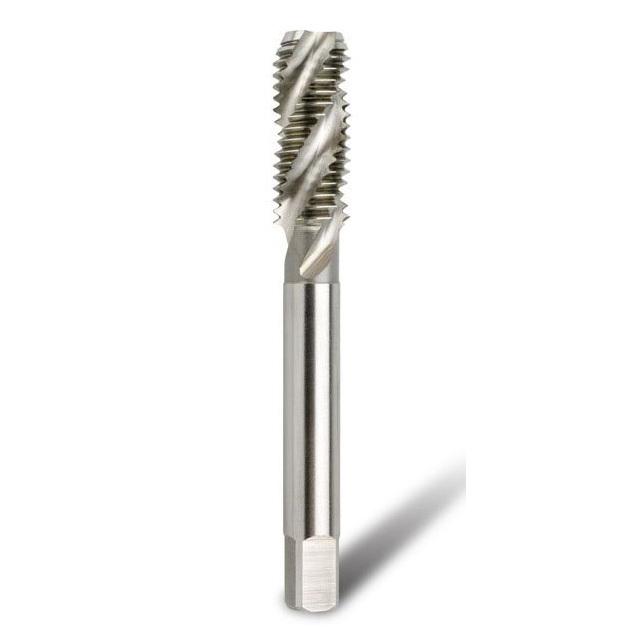In manufacturing and metalworking, taps and dies are essential tools used to create screw threads. They’re indispensable for threading pipes, bolts, and nuts, and are crucial to the production of countless items.

TAPS
A tap thread tool, also known simply as a tap, is a cutting tool used to create threads in a hole. Threads are helical grooves that enable screws, bolts, and other threaded fasteners to securely attach to corresponding holes. The process of using a tap to create threads in a hole is called tapping. Taps are commonly used in metalworking, woodworking, and various other applications.
Tapping is a precise process that requires careful attention to detail and the correct tooling. Here’s a more detailed explanation of tap thread tools:
TAPS PARTS:-
1)TANG
2)SHANK
3)BODY
4)CUTTING FACE
Types of Taps:
There are several types of taps, each designed for specific applications:
1)Straight Flute Taps: Used for through-hole threads, where the tap can go all the way through the material.
2)Spiral Flute Taps: Suitable for blind-hole threads, where the tap cannot pass through the entire depth of the hole.

1)Taper Taps: These have a gradual taper, used to start the threading process in a hole.
2)Plug Taps: Often used after taper taps, these are the most common type and produce most of the thread.
3)Bottoming Taps: Used to create threads near the bottom of a blind hole.
Tapping Process:
The tapping process involves the following steps:
a. Preparing the Hole: Ensure the hole is accurately drilled to the correct size and is free from any debris or obstructions.
b. Selecting the Tap: Choose the appropriate tap type and size for the hole and material being threaded.
c. Lubrication: Use a suitable cutting fluid or lubricant to reduce friction and extend tap life.
d. Starting the Tap: For blind holes, begin with a taper tap to guide the threading process.
e. Cutting Threads: Slowly and steadily rotate the tap into the hole while applying gentle pressure. Reverse the tap occasionally to break off chips and prevent binding.
f. Finishing: After using the plug tap to create most of the thread, use the bottoming tap to complete threading near the bottom of a blind hole.
g. Cleaning: After tapping, clean the hole and remove any remaining chips or debris.
2) Common Issues:
Tapping requires precision, and some common issues to watch out for include:
Tap Breakage: Using excessive force or improper alignment can cause the tap to break.
Cross-Threading: Careful alignment is crucial to avoid cross-threading, which leads to damaged threads.
Tap Wear: Taps wear out over time, affecting thread quality. Using lubricants and proper techniques can prolong their life.
Safety Considerations:
1) Wear appropriate safety gear, such as gloves and eye protection.
2)Use tools in good condition and avoid damaging taps.
3)Apply the right amount of pressure, avoiding excessive force that could lead to breakage.
4)Pay attention to the material being tapped, as some materials may require special considerations.
DIES
A “dies thread tool” typically refers to a tool used for threading operations in metalworking or machining. Threading is the process of creating external or internal threads on a workpiece, allowing it to be connected to other parts, such as bolts, nuts, or pipes.
The dies thread tool is specifically used for cutting external threads on cylindrical workpieces. It consists of a set of cutting edges in the form of small ridges known as teeth, which are arranged in a circular shape. These teeth will cut into the workpiece material as it rotates, creating the desired thread profile.
1. Hand Dies: These are manually operated dies used for manual threading tasks. They are often used in small-scale or repair work.
2. Machine Dies: These are designed to be used with a threading machine or a lathe. They are suitable for larger-scale production and provide more precise and consistent threading results.
Dies thread tools come in various sizes and thread pitch configurations to accommodate different threading requirements. When using a dies thread tool, it’s crucial to use cutting oil or a suitable lubricant to reduce friction and heat generation during the threading process.
Care and Maintenance of Taps and Dies
Clean Your Tools After Use:-Remove any metal shavings or debris and wipe them down with a soft cloth. Apply a light coat of oil to prevent rusting.

Store Them Correctly:-Place your tools in a cool, dry place and keep them away from anything that could cause damage. Invest in a quality carrying case.

Sharpen Taps and Dies:-If you notice that your taps or dies aren’t cutting metal as precisely as they once were, it may be time to properly sharpen them.
Conclusion:-
There is no doubt that taps and dies are essential tools for any metalworking project. From automotive to manufacturing, plumbing to aerospace, they play a crucial role in the creation of items large and small. By understanding the different types of taps and dies, how to use them, and how to care for them, you can ensure that your projects are as precise and professional as possible.
